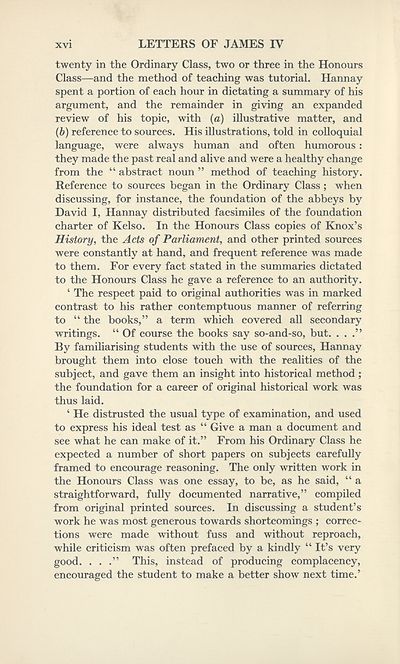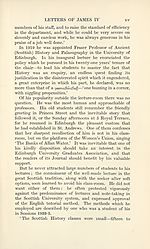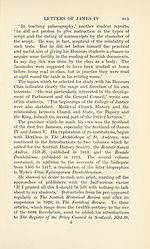Series 3 > Letters of James the Fourth, 1505-1513
(23) Page xvi
Download files
Complete book:
Individual page:
Thumbnail gallery: Grid view | List view

XVI
LETTERS OF JAMES IV
twenty in the Ordinary Class, two or three in the Honours
Class—and the method of teaching was tutorial. Hannay
spent a portion of each hour in dictating a summary of his
argument, and the remainder in giving an expanded
review of his topic, with (a) illustrative matter, and
(b) reference to sources. His illustrations, told in colloquial
language, were always human and often humorous:
they made the past real and alive and were a healthy change
from the “ abstract noun ” method of teaching history.
Reference to sources began in the Ordinary Class ; when
discussing, for instance, the foundation of the abbeys by
David I, Hannay distributed facsimiles of the foundation
charter of Kelso. In the Honours Class copies of Knox’s
History, the Acts of Parliament, and other printed sources
were constantly at hand, and frequent reference was made
to them. For every fact stated in the summaries dictated
to the Honours Class he gave a reference to an authority.
‘ The respect paid to original authorities was in marked
contrast to his rather contemptuous manner of referring
to “ the books,” a term which covered all secondary
writings. “ Of course the books say so-and-so, but. ...”
By familiarising students with the use of sources, Hannay
brought them into close touch with the realities of the
subject, and gave them an insight into historical method ;
the foundation for a career of original historical work was
thus laid.
‘ He distrusted the usual type of examination, and used
to express his ideal test as “ Give a man a document and
see what he can make of it.” From his Ordinary Class he
expected a number of short papers on subjects carefully
framed to encourage reasoning. The only written work in
the Honours Class was one essay, to be, as he said, “ a
straightforward, fully documented narrative,” compiled
from original printed sources. In discussing a student’s
work he was most generous towards shortcomings ; correc¬
tions were made without fuss and without reproach,
while criticism was often prefaced by a kindly “It’s very
good. . . .” This, instead of producing complacency,
encouraged the student to make a better show next time.’
LETTERS OF JAMES IV
twenty in the Ordinary Class, two or three in the Honours
Class—and the method of teaching was tutorial. Hannay
spent a portion of each hour in dictating a summary of his
argument, and the remainder in giving an expanded
review of his topic, with (a) illustrative matter, and
(b) reference to sources. His illustrations, told in colloquial
language, were always human and often humorous:
they made the past real and alive and were a healthy change
from the “ abstract noun ” method of teaching history.
Reference to sources began in the Ordinary Class ; when
discussing, for instance, the foundation of the abbeys by
David I, Hannay distributed facsimiles of the foundation
charter of Kelso. In the Honours Class copies of Knox’s
History, the Acts of Parliament, and other printed sources
were constantly at hand, and frequent reference was made
to them. For every fact stated in the summaries dictated
to the Honours Class he gave a reference to an authority.
‘ The respect paid to original authorities was in marked
contrast to his rather contemptuous manner of referring
to “ the books,” a term which covered all secondary
writings. “ Of course the books say so-and-so, but. ...”
By familiarising students with the use of sources, Hannay
brought them into close touch with the realities of the
subject, and gave them an insight into historical method ;
the foundation for a career of original historical work was
thus laid.
‘ He distrusted the usual type of examination, and used
to express his ideal test as “ Give a man a document and
see what he can make of it.” From his Ordinary Class he
expected a number of short papers on subjects carefully
framed to encourage reasoning. The only written work in
the Honours Class was one essay, to be, as he said, “ a
straightforward, fully documented narrative,” compiled
from original printed sources. In discussing a student’s
work he was most generous towards shortcomings ; correc¬
tions were made without fuss and without reproach,
while criticism was often prefaced by a kindly “It’s very
good. . . .” This, instead of producing complacency,
encouraged the student to make a better show next time.’
Set display mode to:
![]() Universal Viewer |
Universal Viewer | ![]() Mirador |
Large image | Transcription
Mirador |
Large image | Transcription
Images and transcriptions on this page, including medium image downloads, may be used under the Creative Commons Attribution 4.0 International Licence unless otherwise stated. ![]()
| Scottish History Society volumes > Series 3 > Letters of James the Fourth, 1505-1513 > (23) Page xvi |
|---|
| Permanent URL | https://digital.nls.uk/126696867 |
|---|
| Attribution and copyright: |
|
|---|
| Description | Over 180 volumes, published by the Scottish History Society, containing original sources on Scotland's history and people. With a wide range of subjects, the books collectively cover all periods from the 12th to 20th centuries, and reflect changing trends in Scottish history. Sources are accompanied by scholarly interpretation, references and bibliographies. Volumes are usually published annually, and more digitised volumes will be added as they become available. |
|---|


